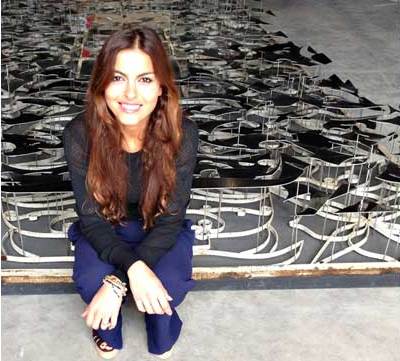This year marks the centenary of Lynn Chadwick (1914–2003). The most notable celebration comprises three exhibitions mounted by Blain|Southern and Blain|Di Donna, providing a major survey of the British sculptor’s 50-year career at three international venues. In Apollo’s upcoming May issue his widow, Éva Chadwick, spoke about the work and legacy of her late husband
What will be on display in the three venues of ‘Retrospectives’?
The London and Berlin galleries have big spaces and they’ll be showing a number of the monumental works. In London, these will include a group from the Pyramids series of 1966, displayed alongside works from 1956 to 1991. The Berlin exhibition – they have an enormous gallery – will feature lots of large stainless-steel Beasts from the early ’90s, together with some smaller early- and middle-period works. The gallery in New York is smaller and will mostly show early works, from 1951 to 1966.
How important is it that this is such an international event?
It’s very important. In the late ’50s, after he won the International Sculpture Prize at Venice, Lynn was a star: the furore around him was the equivalent of what went on with Damien Hirst after his first exhibitions. There was a lot of critical attention then, and a number of American museums including MoMA bought his works. But later, he had fewer solo exhibitions and attracted rather less notice. It seems fitting that his international reputation should be rekindled this year.
How else will the Chadwick centenary be marked?
Lund Humphries is publishing two new books: Lynn Chadwick by Michael Bird and a new edition of the catalogue Lynn Chadwick: Sculptor, which is going to include his lithographs and jewellery. There are a number of smaller exhibitions, too. Museum in the Park in Stroud, for example, is going to present a reconstruction of his studio by Gallery Pangolin [14 June–13 July]. And the Royal Academy has installed four of the Beasts [1989–90] in the courtyard at Burlington House [until 16 May].
For many people, Chadwick is still associated with what Herbert Read called ‘the geometry of fear’ (as he referred to the work of emerging British sculptors including Chadwick, Eduardo Paolozzi and Reg Butler in 1952). Has that label skewed our understanding of his career?
Lynn always objected to this label. He didn’t intellectualise his work, but claimed to construct without preconceptions, ‘almost as a conduit’ he would say, for some ‘vital force’. He rejected being seen as a member of a group – other than that they all made work in the same years – and he felt that people parroted Read’s words without looking at the work at all. He didn’t think his sculptures had fearsome qualities – in fact they’re quite humorous.
Which aspects of Chadwick’s work deserve greater prominence? And what were his greatest sculptural achievements?
The abstract works from the ’60s were overlooked until Pangolin put on the ‘Out of the Shadows’ exhibition in 2009. A lot of people say that Lynn’s early work was better than his later work, but I don’t see it that way. I feel that his oeuvre taken altogether is a great achievement, and that it shows the develop-ment of a very unique technique and his virtuosity in handling his material: from the theriomorphic and insect-like images of the ’50s and ’60s to the more figurative walking and sitting couples, and later the angular steel constructions. From personal, perhaps even sentimental preferences, I’d say his Stranger III [1959] is my favourite. But more objectively the big Ace of Diamonds III [1986–96] is a great work in its simplicity of form, grand scale, and elegant movement achieved by simple means.
Chadwick was among the great technical innovators of the post-war period. How easy is it to convey that now?
He was the last of the great ‘makers’. The directness and simplicity of his method, the uniqueness of his vision combined with the singularity of his technique…these things are visible throughout his oeuvre. Even with the Beasts and Ace of Diamonds series, the outer armatures were first ‘drawn in space’ by welded iron rods. The triangular rods were the hallmark, as it were, of his long career.
Later in life, Chadwick created a sculpture park to display his work at your home at Lypiatt Park, Gloucestershire. Are there plans to open it to the wider public?
For the time being it can’t be opened to the general public – it would be too expensive to meet with the health and safety requirements for public spaces. However, we are able to welcome groups by appointment: schools, friends of museums, charities and others. We have bookings throughout the year for these.
Chadwick’s art-historical importance seems assured. But do you also sense his legacy in the work of contemporary artists?
Lynn had a unique language, so it would be difficult for artists to make adaptations without resorting to copying. But perhaps some have been unconsciously influenced by Lynn’s shapes. Antony Gormley’s Angel of the North looks rather like Lynn’s Stranger III. I do see Lynn’s preoccupation with polygonal shapes echoed in architecture: when I first saw the Shard in the newspaper, I immediately thought of Lynn’s Split series of Formica works from 1966.
‘Retrospectives’ opens at Blain|Southern and Blain|Di Donna in London (1 May), Berlin (3 May) and New York (29 May).
This is a preview from Apollo’s upcoming May issue, which goes on sale on 26 April 2014. Click here to buy Apollo.



